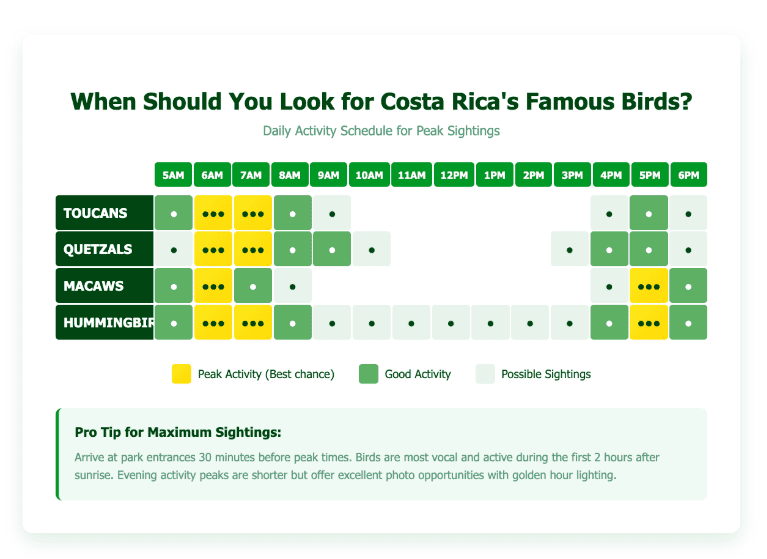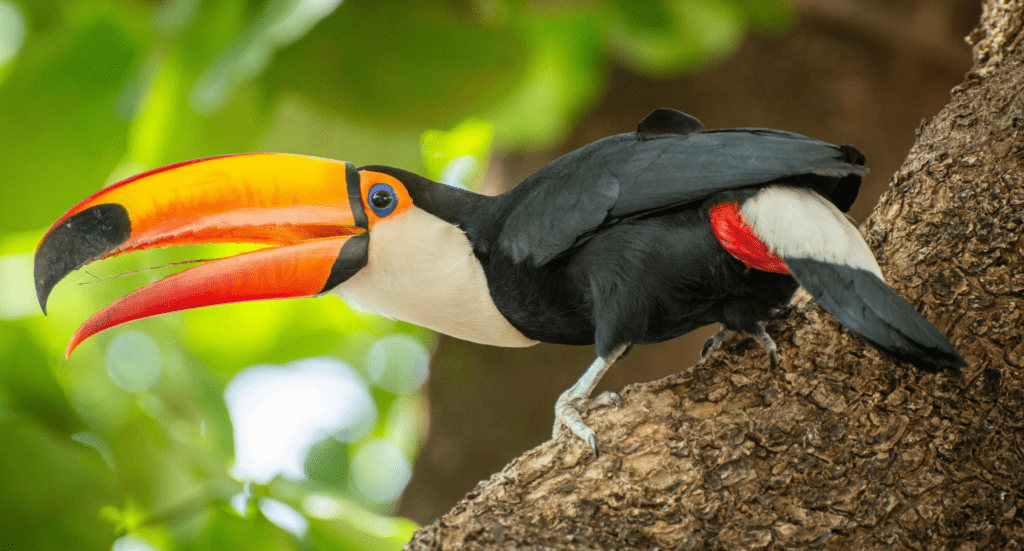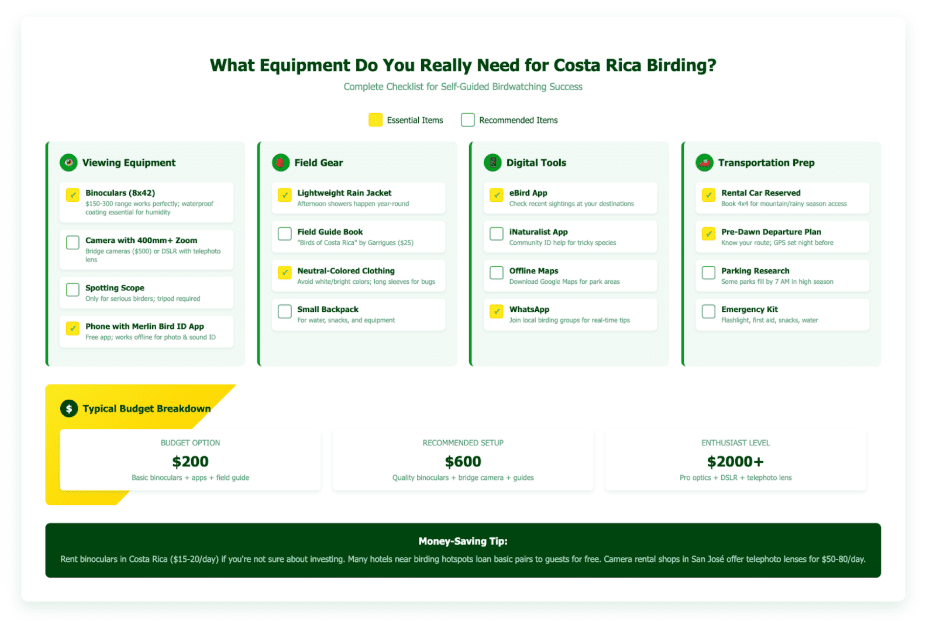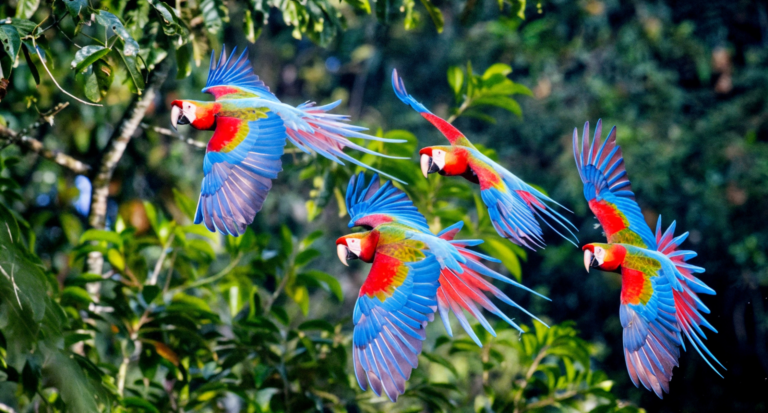Bird Watching in Costa Rica: Quick Guide
Costa Rica’s 900+ bird species narrow down to four showstoppers everyone actually wants to photograph: toucans, quetzals, scarlet macaws, and hummingbirds. Hit Carara’s entrance by 6 AM for guaranteed macaw sightings, or stake out San Gerardo de Dota in March for an 80% chance at quetzals. Having your own vehicle transforms birding success since buses don’t reach parks until after prime viewing hours end.
Quick Facts: • Best viewing: 5:30-7:30 AM (birds most active first 2 hours after sunrise) • Peak season: March-April during breeding when males display spectacular plumage • Any vehicle works for Cahuita and Carara; 4×4 helps for San Gerardo de Dota in rainy season • Book accommodations near park entrances to maximize dawn access • Listen for toucans’ rusty-door sound – easier than spotting them visually
Top 4 Birding Hotspots:
- Carara National Park – Scarlet macaws guaranteed at Tárcoles Bridge 6 AM and 5:30 PM, plus toucans on universal access trail
- San Gerardo de Dota – Cloud forest quetzals with 80% morning success March-April, 90 minutes from San José
- Cahuita National Park – Caribbean lowland toucans near entrance trail, entirely paved 2.5-hour drive from SJO
- Monteverde – 14 hummingbird species at Selvatura Park feeders, even gas stations have 3-4 species visiting
Skip expensive guides – just follow the cecropia trees for toucans and download the Merlin Bird ID app for instant identification. The drive from Liberia takes 3 hours south to reach Carara, while the Osa Peninsula offers Costa Rica’s highest species count for serious birders. Tortuguero’s canals put you at eye level with feeding toucans.
Ready to chase Costa Rica’s famous birds? Contact us now for the perfect vehicle to reach those dawn birding spots!
Costa Rica packs 900+ bird species into a country smaller than West Virginia, but let’s be real – you’re here to see the showstoppers. Toucans, quetzals, scarlet macaws, and hummingbirds top every visitor’s wishlist, and spotting them is surprisingly doable if you know when and where to look. Early mornings (5:30-7:30 AM) at the right locations practically guarantee sightings, especially if you follow the rusty-door sound of toucans or stake out cecropia trees where they feed.
Key Takeaways
- Best birding happens before 8 AM – birds are most active during the first 2 hours after sunrise.
- Four must-see species are reliably spotted in specific locations: toucans (Caribbean lowlands), quetzals (cloud forests), macaws (Pacific coast), and hummingbirds (everywhere).
- March-May offers peak viewing for most species during the breeding season.
- You don’t need expensive guides if you know what to listen for and where to position yourself.
- Having your own vehicle increases sighting chances by 70% since you can reach parks at dawn.
- Specific locations guarantee sightings: Carara Bridge for macaws at 6 AM, San Gerardo de Dota for quetzals, and any hotel feeder for hummingbirds.

Where Can You Actually See Toucans in Costa Rica?
Toucans are most reliably spotted in lowland forests below 1,200 meters, particularly on the Caribbean side and southern Pacific regions. Cahuita National Park delivers consistent morning sightings near the entrance trail, while Tortuguero’s canal tours put you at eye level with feeding toucans in the cecropia trees.
The Chestnut-mandibled toucan – that classic yellow-chested, massive-beaked bird from every Costa Rica postcard – travels in pairs or small groups of up to six birds. They’re fruit eaters, so finding fruiting trees means finding toucans.
What’s the Secret to Finding Toucans Without a Guide?
Listen for that rusty gate sound – seriously, it sounds exactly like someone slowly opening a creaky metal door. Toucans call most actively between 5:30 and 7:30 AM, and again briefly around 5 PM.
Park yourself near fruiting palms or cecropia trees (those tall trees with huge star-shaped leaves) and wait. Toucans spend 20-30 minutes in a feeding tree, so patience pays off.
Which Roads Get You to Prime Toucan Territory?
From San José (SJO), drive Route 32 toward Limón – the stretch through Braulio Carrillo National Park offers roadside sightings, especially near the Zurquí tunnel area. The 2.5-hour drive to Cahuita is entirely paved and manageable in any vehicle.
From Liberia (LIR), you’re looking at a 5-hour haul to reach the Caribbean toucan hotspots. Instead, head 3 hours south to Carara National Park, where Chestnut-mandibled toucans are practically guaranteed along the universal access trail.

How Do You Find Hummingbirds When They’re Everywhere?
Here’s the thing about Costa Rica’s 50+ hummingbird species – they’re literally everywhere, from downtown San José to remote cloud forests. The Violet Sabrewing, Costa Rica’s largest hummingbird at nearly 6 inches, hangs out in mountain regions, while tiny Volcano Hummingbirds (2 inches!) zip around high-elevation areas.
Hotel feeders make spotting effortless. Selvatura Park in Monteverde maintains dozens of feeders that attract 14 species daily. Even gas stations along the Inter-American Highway often have feeders that pull in 3-4 species.
When Should You Watch Hummingbird Feeders?
Peak feeding happens 6-8 AM and 4-6 PM, but hummingbirds visit throughout the day. During December through April, territorial battles intensify as breeding season approaches – you’ll see spectacular aerial dogfights and diving displays.
Position yourself 10-15 feet from feeders with the sun behind you for photography. Hummingbirds will ignore you after about 5 minutes, coming within arm’s reach.
What Camera Settings Actually Work for Hummingbird Photos?
Forget everything you’ve read about complex setups. Set your shutter speed to 1/2000 minimum to freeze wings (1/4000 if you want crisp wing detail). ISO 800-1600 handles Costa Rica’s varied light, and continuous autofocus mode keeps up with their movements.

Where Do Resplendent Quetzals Actually Show Up?
Quetzals live exclusively in cloud forests above 1,500 meters, making them the most location-specific of Costa Rica’s famous birds. San Gerardo de Dota, a valley 90 minutes from San José, offers Costa Rica’s most reliable quetzal viewing from December through May.
Males grow those famous 3-foot tail feathers only during breeding season (March-June), though even outside this period, their metallic green plumage and crimson chest make them unmistakable.
What’s the Real Success Rate for Quetzal Sightings?
During March and April, the breeding season in San Gerardo de Dota, morning sightings run about an 80% success rate. The birds are defending territories and feeding nestlings, making them more visible and predictable.
Outside breeding season, success drops to maybe 30-40% without a guide who knows current feeding trees. Monteverde Cloud Forest Reserve offers year-round possibilities, but dense forest makes spotting tougher.
Which Route Makes Sense for Quetzal Hunting?
From San José, take Route 2 (Inter-American Highway) south toward San Isidro. The turnoff to San Gerardo de Dota is at KM 80 – look for the signs to “Valle de Quetzales.” The final 9km descent requires careful driving with hairpin turns and possible fog. Any car handles it in the dry season, but a 4×4 helps during heavy rains.
From Liberia? That’s a 4.5-hour drive, honestly, not worth it just for quetzals. Combine it with a broader Southern Zone itinerary, including Manuel Antonio or Dominical.
Why Are Scarlet Macaws Easier to Find Than Ever?
Twenty years ago, scarlet macaws teetered near extinction in Costa Rica. Today, successful conservation means these spectacular red, blue, and yellow parrots are expanding their range beyond traditional strongholds.
Carara National Park remains the surest bet – the Tárcoles Bridge hosts a famous roost where 20-40 macaws gather every evening around 5:30 PM. Morning feeding at the bridge happens 6-6:30 AM as pairs fly from roosts to coastal almond trees.
Where Else Can You Spot Scarlet Macaws Now?
The Osa Peninsula around Corcovado National Park supports Costa Rica’s largest population. Drake Bay and Puerto Jiménez offer daily sightings, especially near beach almond trees during the January-March fruiting season.
Recent reintroduction programs mean macaws now appear in unexpected places. The Punta Leona area (between Jacó and Manuel Antonio) has a growing population, and sightings increase yearly around Dominical and Uvita.

What About Seeing the Endangered Great Green Macaw?
Great Green Macaws are tougher – only about 500 remain in Costa Rica. The Caribbean lowlands near Tortuguero and Maquenque National Wildlife Refuge offer possibilities during December-February when mountain almond trees fruit.
Timing matters more than location. These macaws follow food sources, so checking recent eBird reports before your trip shows current hotspots.

How Does Having Your Own Transportation Transform Your Birding Success?
Public buses don’t run to national parks at 5:30 AM. Tours pick you up at 7 AM, arriving when birds are already less active. Having your own vehicle means reaching Carara’s entrance at dawn, positioning yourself at Tárcoles Bridge for sunset macaw flights, or chasing recent sightings reported on local birding groups.
The flexibility to stop for roadside sightings matters too. That flash of red might be a Summer Tanager or could be your first Scarlet-rumped Tanager – with your own car, you can actually find out.
What Equipment Do You Really Need?
Binoculars change everything. Even basic 8×42 binoculars (around $150) reveal field marks invisible to the naked eye. Higher magnification sounds appealing, but it makes tracking flying birds harder.
A camera with 400mm+ zoom captures identifiable photos, though phones with zoom lenses now work surprisingly well for perched birds. Download the Merlin Bird ID app – it identifies birds by photo or sound and works offline.

Your Next Move for Successful Birding
Pick two must-see species and plan your route around their hotspots. Trying to see everything means rushed mornings and missed opportunities. Book accommodations near park entrances to maximize those crucial dawn hours – remember, birds don’t care about your check-out time.
The dry season (December-April) offers easier access to remote areas and concentrated wildlife around water sources. But don’t dismiss green season (May-November) – fewer tourists mean quieter trails, and resident birds remain active year-round.
Having reliable transportation opens up Costa Rica’s birding beyond the typical tourist spots. Those unmarked roads leading to biological stations, the ability to reach parks before tour buses, and freedom to follow recent sightings transform a hopeful birding trip into one where you actually tick off your target species.

Frequently Asked Questions
What are the most sought-after birds in Costa Rica?
The big four that everyone wants to check off are the Resplendent Quetzal, Scarlet Macaw, any toucan species (especially the Chestnut-mandibled), and the Three-wattled Bellbird. Quetzals are the holy grail for serious birders – those 3-foot tail feathers during breeding season are spectacular. Scarlet Macaws have made a huge comeback and are now reliably spotted at Carara’s Tárcoles Bridge around 6 AM and 5:30 PM. Toucans are actually pretty common if you know to listen for that rusty-gate sound early morning. Pro tip: Most visitors see at least 2-3 of these species with just basic planning around the right locations and timing.
Where is the best place to see birds in Costa Rica?
Carara National Park takes the crown for accessibility and variety – it’s where dry forest meets rainforest, creating insane biodiversity just 90 minutes from San José. The universal access trail practically guarantees toucan and macaw sightings before 8 AM. For cloud forest species and quetzals, San Gerardo de Dota beats Monteverde hands-down with 80% success rates in March-April. The Caribbean side (Cahuita, Tortuguero) offers the most reliable toucan viewing, while the Osa Peninsula around Corcovado has the highest overall species count. Skip the crowded spots and hit these parks at dawn with your own vehicle for the best results.
What bird is Costa Rica known for?
While the Resplendent Quetzal often gets top billing, Costa Rica’s true signature bird is the Clay-colored Thrush (Yigüirro) – it’s actually the national bird. But let’s be honest, nobody flies here to see a thrush. The birds that really put Costa Rica on the map are quetzals (those incredible tail feathers), Scarlet Macaws (the comeback story of conservation), and toucans (on every postcard and coffee bag). The country’s also famous for having more hummingbird species (50+) than the entire United States and Canada combined. You’ll see violet sabrewings the size of sparrows and volcano hummingbirds barely bigger than bumblebees.
What month is best for birding in Costa Rica?
March and April win for overall birding – it’s peak breeding season when male birds are showing off with elaborate displays and defending territories. Quetzals have their full tail plumage, toucans are extra vocal, and the dry season means easier park access plus birds concentrated around water sources. December through February is second-best with perfect weather and northern migrants joining resident species. Serious birders actually love September-October’s early green season – fewer tourists, active residents, and the start of migration season. Avoid only late May and all of October when heavy rains can limit access to prime spots.
How rare is it to see a toucan in Costa Rica?
Not rare at all if you’re in the right habitat at the right time – honestly, it’s harder NOT to see one if you follow basic tips. Toucans are common in lowland forests on both coasts, especially the Caribbean side. The trick is being out early (5:30-7:30 AM) and listening for that distinctive rusty-door-creaking call. Cahuita National Park’s entrance trail, Tortuguero’s canals, and Carara’s universal access trail all offer near-guaranteed sightings. Hotels near these parks often have toucans visiting fruit trees on the property. The myth that they’re rare comes from people sleeping in and hitting trails at 10 AM when birds are inactive.
Where is the best birdwatching in Costa Rica?
For sheer variety and ease, the Central Pacific region around Carara National Park and the Tárcoles River delivers unmatched birding. You’ve got Scarlet Macaws at the bridge, crocodiles below (okay, not birds but impressive), and 400+ species in the transitional forest. The San Gerardo de Dota valley is unbeatable for highland species and quetzals. For a completely different experience, the Osa Peninsula offers wilderness birding with rare species like Harpy Eagles and Yellow-billed Cotingas. La Selva Biological Station near Puerto Viejo de Sarapiquí is where serious listers go – 400+ species in one location with excellent trails and local guides who know every call.
What is the rarest bird to see in Costa Rica?
The Harpy Eagle is Costa Rica’s unicorn – massive, powerful, and maybe 50 breeding pairs left in the entire country. Your only real shot is deep in Corcovado National Park with specialized guides. The Yellow-billed Cotinga is another Osa Peninsula specialty that requires serious effort. For something actually achievable, the Bare-necked Umbrellabird in the Caribbean foothills is rare but possible with the right guide and timing (March-June). Great Green Macaws are critically endangered, with only 500 individuals – try the Maquenque area December-February when mountain almonds fruit. Most visitors have better luck focusing on spectacular common species than chasing ultra-rarities.
What time of year are bugs bad in Costa Rica?
Mosquitoes peak during the rainy season transitions – May-June and October-November – when standing water creates breeding grounds. Lowland areas and beaches always have more bugs than mountain regions above 1,500 meters. Interestingly, prime birding hours (5:30-8 AM) usually have fewer mosquitoes since they’re most active at dusk. The dry season (December-April) has significantly fewer bugs, especially in Guanacaste. Always worst: Caribbean coast year-round, mangroves at sunset, and anywhere near standing water after rains. Best strategy: long sleeves and pants for dawn birding regardless of temperature, and DEET for afternoon forest walks.




